Last updated: July 8, 2024
Article
Indiana's Unrivaled Sand-Dunes—A National Park Opportunity

The idea to have a national park at the Indiana Dunes was a desire that percolated for decades. The first major push, led by Jens Jensen and Henry Cowles' Prairie Club of Chicago, began in the early 1910's with their organized "Saturday Afternoon Walking Trips."
Their efforts involved Stephen Mather, first Director of the National Park Service, who initiated a feasibility study in 1916. He held hearings in Chicago where scientists; artists; reformers; history and nature lovers all expressed their support of a national park project. These and other early park advocates like Bess Sheehan helped plan a massive outdoor performance known as the Dunes Pageant in spring of 1917.
Although entering World War I put the Dunes' national park project on hold, advocates continued to drum up support with pieces like this National Geographic article from May of 1919:
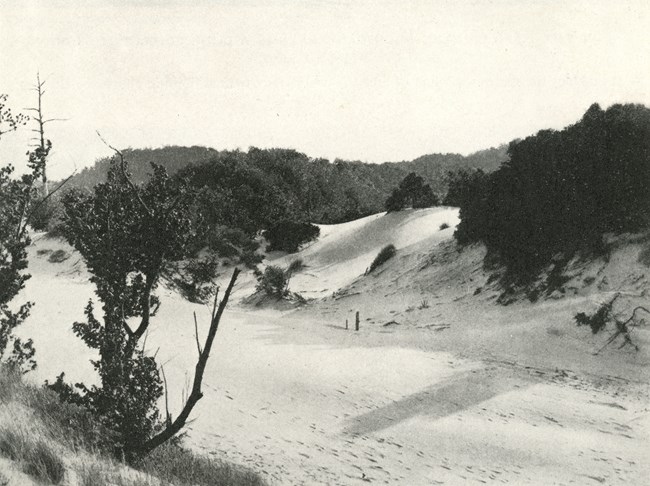
Photograph by Alfred L. Fitch / Joseph Gruzalski Collection
By Orpheus Moyer Schantz
National Geographic Magazine; May, 1919A dune region ordinarily signifies an inhospitable, wind-swept tract of country, barren of vegetation and sparsely inhabited by animal life. The term “sand dune” long ago denoted a land to be avoided by travelers whenever possible. Lack of water, intense heat, and the ever-drifting sand itself were sufficient causes for shunning any dune country as a highway. Charles Kingsley, in Westward Ho, says: “The Spaniards neared and neared the fatal dunes that fringed the shore for many a weary mile.”
The dunes of the Atlantic coast, driven inland by the terrific storms off the ocean, at times have devasted large areas of fertile land, relentlessly destroying all vegetation, and the dune regions of interior America were the bane of early pioneers.
At the head of Lake Michigan, including the entire shoreline of Indiana and parts of the adjoining shores of Illinois and Michigan, there is a dune country, unique and wonderful and entirely different from our usual ideas of sand-dunes.
The vegetation of the average desert or sandy region is usually an interesting example of survival of the fittest, and most of the plant families remaining have adapted themselves to the severe conditions of their environment. Desert plants, too, are often strikingly beautiful when in blossom; but their period of growth and luxury is very short, lasting only through the rainy season.
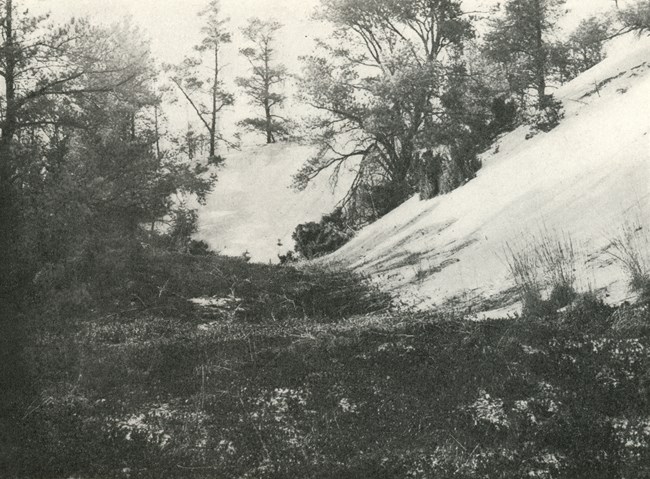
Photograph by Arthur E. Anderson / Joseph Gruzalski Collection
A Sea of Sand, But No Desert Drought
Conditions are reversed in the Indiana Dunes, for here there is never a long period of drought, and in place of a desert area there is a natural propagating garden, where a most astonishing number of rare and beautiful plants congregate, having migrated both from the north and south to this unusually favored locality.
Here, on the shores of a great freshwater sea, whose moisture is constantly being carried southward by the prevailing northwest winds, and tempered both in summer and winter by its position on the lake, is a region so wonderful that is should be kept for all time as a great natural park for study and the recreation of millions of people of the Middle West.
There are about 20 miles of shoreline, averaging a mile or more in width and containing approximately 30 square miles of land n the dunes, still unspoiled by commercial industries. This region is situated within easy reach of more than 10,000,000 people at a nominal cost for transportation.
A visit to almost any one of the national parks is a luxury beyond the reach of the majority of the people of the Middle West; but the Lake Michigan dune region can be visited at all seasons and at a cost of, at the most, a few dollars. The dunes are popular even in midwinter, and may a party of students and other outdoor enthusiasts has enjoyed the scenery and the bracing air of the lake at that time of year.
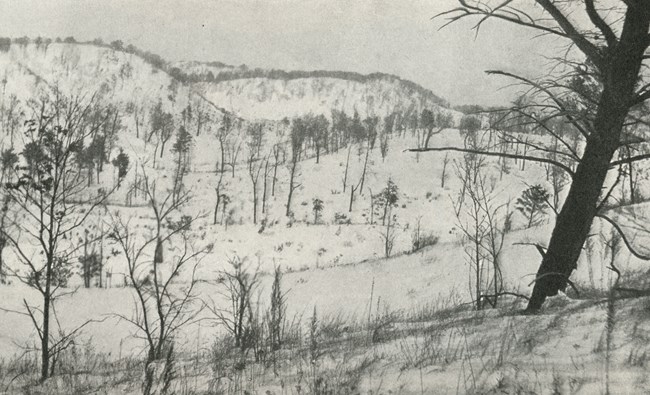
Photograph by A. E. Ormes / Joseph Gruzalski Collection
Many Charms For Many Men
The attractions of the dunes are so varied that all classes may here find recreation suited to their wishes. The tramper, the geologist, the botanist, the zoologist, the study of early American history, and those who seek only fresh air and clear skies, can find all they desire, and more than they hoped for, in this wonderland of sandy beach and forested lake shore.
The outlines of the dunes are always graceful; for Nature, though sometimes cruel, displays wonderful skill as an artist, and the exposed wind-cared sands are arranged in beautiful curves and outlines against the sky.
The topography of the dunes lends itself to the formation of marvelous plant societies: great shallow ponds, with their typical borders of marsh-loving plants ; deep, sheltered hollows, perfectly dry at the bottom ; active stream beds, thickly fringed with willows, alders, and buttonbush, with thickets of giant mallows on the mucky shore ; north slopes with trailing arbutus, wintergreen, partridge berry, hepaticas, and violets, and rare ferns and orchids spread in artistic profusion ; moving dunes, whose leeward sides extend slowly and surely south ; old dunes, clothed to their crests with vegetation, and at intervals “blow-outs,” where reverse winds have uncovered ghostly tree trunks, gray and weather-beaten and entirely denuded of bark, but the wood still sound and perfectly preserved by the sand shroud with which it was surrounded.
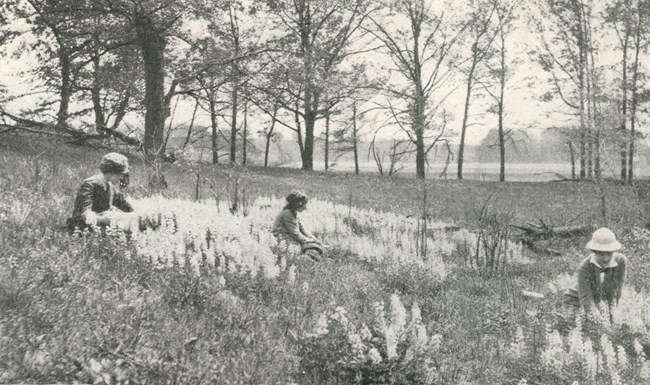
Photograph by H. Mertsky / Joseph Gruzalski Collection
Plant Life of Marvelous Variety
Many trees adapt themselves to the severe conditions on the more exposed dunes, frequently sending out roots from the trunk to take advantage of the encroaching sand, and if again uncovered the roots immediately function as branches. This is particularly true of the cottonwood, which also sends out roots of remarkable length close to the surface of the sand, in this way making use of the surface moisture.
Trees, shrubs, and many plant species from the far north grow side by side with others whose natural habitat is many miles south of the lake, and the plant life is bewildering to the uninitiated and a joy to the botanist. The combination of underlying sand and humus, with abundant moisture, makes a condition of soil that is ideal, and the result is a luxuriant plant growth that is almost tropical.
The dune-floor vegetation is more striking than the arborescent growth, and the wealth of herbaceous plant life is remarkable. Even on the exposed lake beach and on newly formed sand drifts pioneer plants are constantly springing up. Hardy grasses, sea rockets, artemisias, sand cherries, and many others take advantage of the slightest opportunity, and around these plants embryo dunes form, which in time grow and join the ever-changing and fascinating panorama of dune succession.
As soon as a slight covering of humus accumulates, possession is taken by the stronger plant growth and bearberry, juniper, arrow woods, and sumacs soon fill up the vacant spaces, preparing the way for tree growth that is waiting its turn.
The black oak is the most conspicuous tree of the older dunes, but it is accompanied by many others, mostly deciduous, although there are a few evergreens and one other conifer—the tamarack.
Basswood, poplars, tulip, sassafras, juneberry, flowering dogwood, white and gray pines, and occasionally white oaks, are all to be found in the drier parts of the dunes; and in the lower lands sour gum, red maple, swamp white oak, pawpaw, cherry, and the larger sumacs grow luxuriantly in the peaty soil.
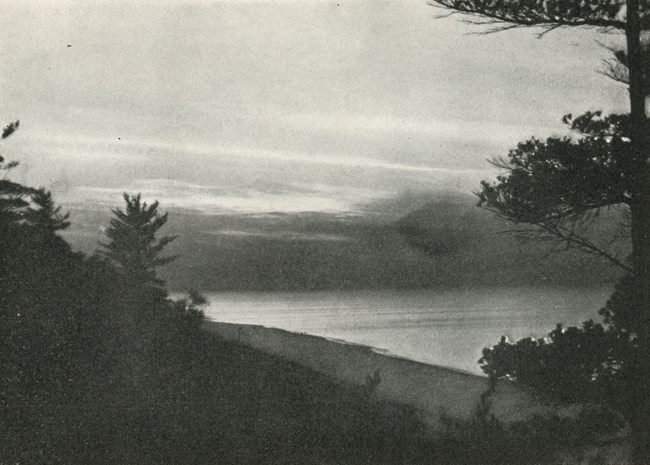
Photograph by Arthur E. Anderson / Joseph Gruzalski Collection
A New Green For Every Season
Each season in the dunes has its own individual attraction. In springtime the dark greens of pines and junipers make a fitting background for the delicate shades of the opening foliage of the deciduous trees, with their soft greens, pinks, and reds. Great splashes of white blossoms of shad bush, cherry, plum, and viburnums; the striking blossoms of flowering dogwood and buttonbush; masses of red maple pendants and the delicate coloring of the oaks make a strong appeal to the esthetic sense of the lover of Nature.
Over all the taller growth are scattered draperies of vines, softening the rigid outlines and adding their blossoms to the marvelous display.
The herbaceous plant life is even more varied and wonderful. Great masses of birds-foot and other violets, lupines, phlox of different colors, trilliums, waxy bells of wintergreen and blueberry, hepaticas, trailing arbutus—not just a few flowers, but acres of them and miles of acres—make a natural paradise which cannot be artificially duplicated.
The marshes have their own individuality of sedges, cat tails, reeds, and borders of the larger ferns—royal, cinnamon, and interrupted. The Virginia chain fern in one of the drier marshes crowds out the less vigorous plant life, coloring with its fertile fronds great stretches of the marsh a beautiful sepia. The blending of browns and greens in the marshes softens the landscape to an exquisite symphony of color in pleasing contrast to the more vivid coloring of the higher land adjoining.
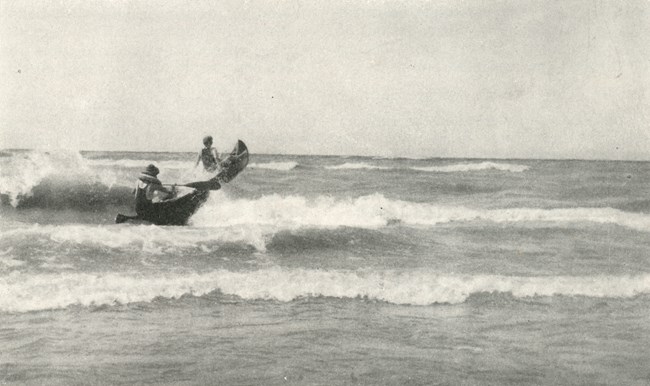
Photograph by L. T. Gable / Joseph Gruzalski Collection
Autumn’s Flaming Dune Landscape
It is in autumn, however, that the dune coloration is at its best, for then the entire region becomes a flaming landscape of gorgeous reds and yellows. Nature goes into her winter rest with a last effort in color that is beyond adequate description. The sour gum, red maple, sumacs, and sassafras discard their modesty and vie with each other in a gorgeous riot of autumn coloring. The foliage of the black oak, as it changes, combines red, green, and bronze, and covers the ridges with a garment of beauty.
Many of the trees and lesser shrubs and other plants bear edible fruits, providing a sumptuous larder for hosts of birds and small animals. The bird life of the region surrounding the end of Lake Michigan is very abundant, and during migrations nowhere in the United States are there more varieties of both land and shore birds to be seen than here.
Conditions of food, shelter, and climate are particularly favorable for these visitors. Although the game birds are sadly persecuted, they still visit the dunes in great numbers each year, scarcely a season passing without having among its records some rare migratory visitor or new nesting record.
The ruffed grouse, golden eagle, horned owl, and the great blue heron still visit the dunes, and in winter-time the evening grosbeak, crossbills, and pine finches are attracted by the wealth of food.
Geologically, the dunes and distinctly traceable old shorelines tell the fascinating story of the Glacial period antedating Lake Michigan. The near-by universities bring their classes to the dunes as a most necessary object-lesson of their natural-science courses.
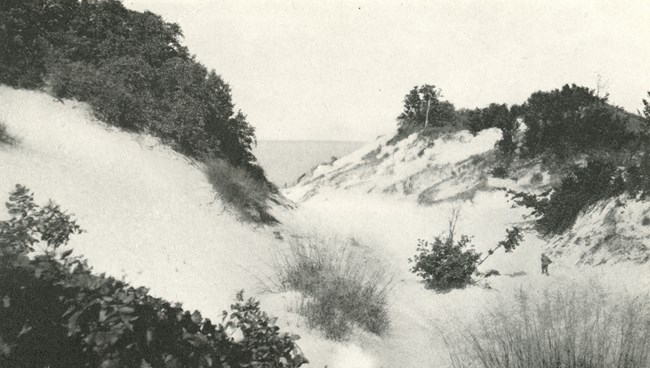
Photograph by H. Mertsky / Joseph Gruzalski Collection
Historic Association In the Dune Country
Historically, also, the dunes have their place in the earlier history of the West. The old Indian trails can still be pointed out, and it was through the dunes that the pioneer French found their way from Detroit to the site of Chicago, at the mouth of the Chicago River.
Nature organizations of Chicago and Indiana have done much to bring the dunes to the attention of thousands of people who never knew them except superficially from the railroad or trolley line, and each year they are becoming better known and appreciated.
As a result of this education the residents of the adjacent country are beginning to realize that they have a truly remarkable forest area within a few hours’ ride ; that miles of beautiful beaches are free to the tired city dweller, and that here they can go out in the pure air and see the sun rise and set over the lake, without a sign of a skyscraper or factory visible anywhere.
The consideration of the dunes as a national park has received the serious attention of Congress to the extent that in 1916 a public hearing was held in Chicago to gather data in connection with the proposed project. At this hearing hundreds of men and women of prominence gave evidence as to its advantages.
In the spring of 1917 a pageant was given in a great natural amphitheater in the dunes, which vividly portrayed the early history of the dunes, illustrating with striking exactness the stirring events which made it American.
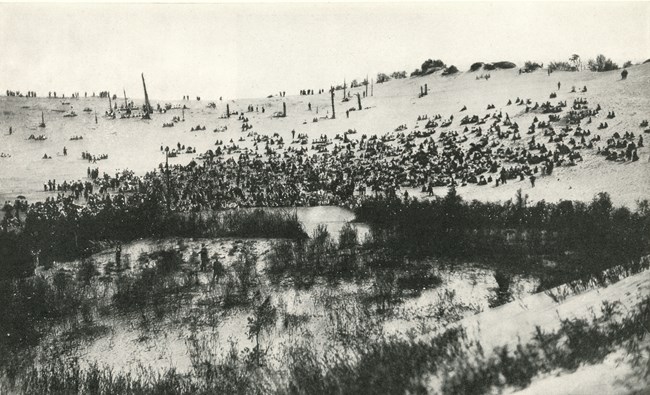
Photograph by H. P. Cook / Joseph Gruzalski Collection
Shall They Be Preserved?
The interest of the public in the dune shas been materially advanced by the public hearing and the great pageant, and a new epoch has been reached in the campaign for their preservation. If this region is allowed to pass into the hands of commercial industries, the people of the State of Indiana and of the entire country will lose for all time their free access to Lake Michigan.
The importance of prompt action cannot be urged too strongly, as the demand for large tracts of land with railway and water facilities would soon result in the destruction of the natural advantages of this remnant of scenic beauty and fascinating forest and plant life.
Under commercial occupancy the growth of centuries could be destroyed in a short time. It would be a catastrophe if this opportunity for preserving an incomparable breathing spot on Lake Michigan should be neglected.
